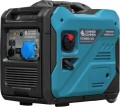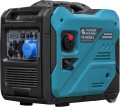Motor type
Model name of the engine installed in the generator. Knowing this name, you can, if necessary, find detailed data on the engine and clarify how it meets your requirements. In addition, model data may be needed for some specific tasks, including maintenance and repair.
Note that modern generators are often equipped with
branded engines from famous manufacturers: Honda, John Deere, Mitsubishi, Volvo, etc. Such engines are more expensive than similar units from little-known brands, but this is offset by higher quality and/or solid warranty conditions , and in many cases, the ease of finding spare parts and additional documentation (such as manuals for special maintenance and minor repairs).
Engine size
The working volume of the engine in a gasoline or diesel generator (see "Fuel"). Theoretically, more volume usually means more power, but in fact, everything is not so clear. Firstly, the specific power strongly depends on the type of fuel, and in gasoline units, also on the type of internal combustion engine (see above). Secondly, similar engines of the same power can have different volumes, and there is a practical point here: with the same power, a larger engine consumes more fuel, but by itself it can cost less.
Power
The operating power of the engine installed in the generator. Traditionally stated in horsepower; 1 HP approximately equal to 735 watts.
First of all, the rated power of the generator directly depends on this indicator (see above): in principle, it cannot be higher than the engine power, moreover, part of the engine power is spent on heat, friction and other losses. And the smaller the difference between these capacities, the higher the efficiency of the generator and the more economical it is. However high efficiency affects the cost, but this difference can pay off with regular use due to fuel savings.
Launch type
Method of starting an electric generator engine. To start an internal combustion engine (gasoline or diesel, see “Fuel”), in any case, it is necessary to rotate the engine shaft; you can do this in two ways:
-
Manual. With this starting method, the initial impulse is transmitted to the engine manually - usually the user needs to forcefully pull the cable that spins a special flywheel. The simplest in design and cheapest starting method, the additional equipment requires only the cable itself with a flywheel. On the other hand, it may require significant muscular effort from the user and is not well suited for high-power units.
—
Electric starter. With this type of starting, the engine shaft is rotated using a special electric motor, which is called a starter; The starter is powered by its own battery. This option for starting the generator power unit is the easiest for the user and requires a minimum of effort. Depending on the implementation of the electric starter, it is usually enough to turn the key in the ignition, press a button, turn a knob or spin a special drum, etc. The power of modern starters is sufficient even for heavy engines where manual starting is difficult or impossible. Also note that an electric starter is by definition required to use ATS autostart (see Features). On the other hand, additional equipment affects the weight and cost of the unit, sometimes quite notic
...eably. Therefore, such starting systems are used mainly where they cannot be avoided - in the aforementioned heavy equipment, as well as generators with ATS.USB charging port
The generator has
a USB connector(one or more) for charging various devices. Most modern smartphones and tablets can be charged from USB, and this charging method is also found in many other equipment - from cameras and flashlights to electric screwdrivers and radio-controlled models. The standard supply voltage through this connector is 5 V, but the power may be different, it should be specified separately.
Output 12 V
Existence in the generator of an
output with a direct current and voltage of 12 V. The main function of this output is to charge car batteries, as well as power devices originally intended for cars (recall, 12 V is the standard voltage of on-board networks in cars).
The following types of 12-volt outputs are found in generators:
- Terminals. Terminals are used to connect wires directly without using any plugs. This connection is the most reliable.
- Socket. Socket outlet for a plug with two flat pins, designed to connect 12-volt consumers. Holes in sockets come in different layouts, which you need to pay attention to.
- Cigarette lighter. The so-called "car socket", which in many cars is combined with a cigarette lighter socket (hence the name). Such connectors are used to power various automotive devices and accessories.
Functions
-
DC output (DC 12 V). The presence in the generator of an output with direct power and a voltage of 12 V. The main function of this output is to charge car batteries, as well as power devices originally intended for cars (remember, 12 V is the standard voltage of on-board networks in passenger cars).
-
USB port for charging. The generator has a USB connector (one or more) for charging various devices. Most modern smartphones and tablets can be charged from USB; this charging method is also found in many other equipment - from cameras and flashlights to electric screwdrivers and radio-controlled models. The standard supply voltage through this connector is 5 V, but the power may vary and should be specified separately.
-
Synchronization with a smartphone. Synchronization with a smartphone allows you to control the operation of the generator remotely. Thanks to this, the user does not need to approach the device to, for example, start or stop it. Additionally, synchronization with a smartphone allows you to monitor the parameters of the generated electric power remotely and in real time. On the other hand, this will require a constant connection to the Internet and specialized software that must be installed on your smartphone.
-
Autorun (ATS). A function that allows the generator to turn on automatically under
...certain conditions, without user action. Autostart is used mainly when using a generator as a backup power source: while the main power is on, the unit is turned off, and if the mains voltage disappears, the ATS starts the engine, and power to the load begins to flow from the generator. Note that the presence of autostart is indicated only if the generator is initially equipped with an ATS electronic unit; models with the ability to connect such a unit are placed in a separate category (see below).
- Connector for the ATS block. A connector that allows you to connect an external autorun unit (ATS) to the generator; The block itself is not included. See above for more details on autorun; We note here that for some users this function is not initially needed, but it may be needed in the future - for example, if the generator is initially used in the construction of a house, and then it is planned to be installed in the same house as a backup power source. In such situations, this configuration option will be optimal: when purchasing the generator itself, you will not have to overpay for the ATS unit, and later, if necessary, you can buy and connect such a unit separately.
- Automatic voltage regulator (AVR). An automatic regulator that allows you to maintain a constant voltage level at the generator output. Such a regulator smoothes out differences arising from changes in engine rotation speed; This is especially important when connecting devices that are sensitive to power stability. It is worth noting that the presence of AVR is practically mandatory for synchronous generators (see “Alternator”), but in other varieties this function is not found: in asynchronous and duplex units it is not applicable in principle, and in inverter units the role of the regulator is played by the inverter itself, and they do not require additional electronics.
— Display. Own display mounted on the generator body. As a rule, this is a simple LCD screen that can only display numbers and some special characters. However, even such a screen can display various useful information: voltage, frequency, hour meter data, low fuel level warning, failure messages with error codes, etc. Thanks to this, control becomes more convenient and visual.
- Hour meter. A device that counts the total time that the electric generator engine has worked since it was first turned on. This helps to determine the general wear and tear of the engine and the need for its repair/replacement, which can be useful both when using the device for a long time, and, for example, to assess the quality of the product when purchasing a used electric generator. It is usually impossible to reset the hour meter without serious intervention in the design of the device.
— Voltmeter. A device that displays the power voltage output by the generator. The voltmeter can be made in the form of a separate dial scale, or its readings can be displayed on the generator’s own display (see above). In any case, this function allows you to carefully control the operating mode of the unit and reduces the risk that unacceptable voltage will be applied to the load.
- Parallel connection. The presence in the design of the generator of special connectors through which two or more units can be connected to a single electrical network (usually with the help of an additional device). This type of connection is used when one unit is not able to pull the entire load and the connection power exceeds the capabilities of the device itself. Also, a similar scheme has found popularity if one of the units is planned to be used as a backup power source.
- Remote start. Presence in a set of delivery of the generator of the remote control. It is made in the form of a wireless key fob and allows you to turn on/off the device from a distance without going near it.Weight
The total weight of the unit - as a rule, excluding fuel; The full fill weight can be easily determined by knowing the tank capacity.
In general, more powerful generators inevitably turn out to be heavier, but models with similar characteristics can differ noticeably in weight. When assessing these differences and generally choosing an option based on weight, it is worth taking into account the specific application of the generator. So, if the device will often be moved from place to place - for example, when used “on the road” - it may be worth paying attention to lighter units that are more convenient to transport. However, it is worth considering that the downside of a lightweight design is often an increased cost or a reduced degree of protection. But for stationary use, you can not pay much attention to this parameter - or even the opposite: choose a heavier (and, as a rule, more advanced and functional) option.
Regarding specific numbers, it is worth noting that modern generators in general are quite massive. So, a small weight for such equipment is considered not only
up to 20 kg, but even
20 – 30 kg ; Many units weigh
150–200 kg, or even
more, and the weight of stationary industrial models is already measured in tons.

